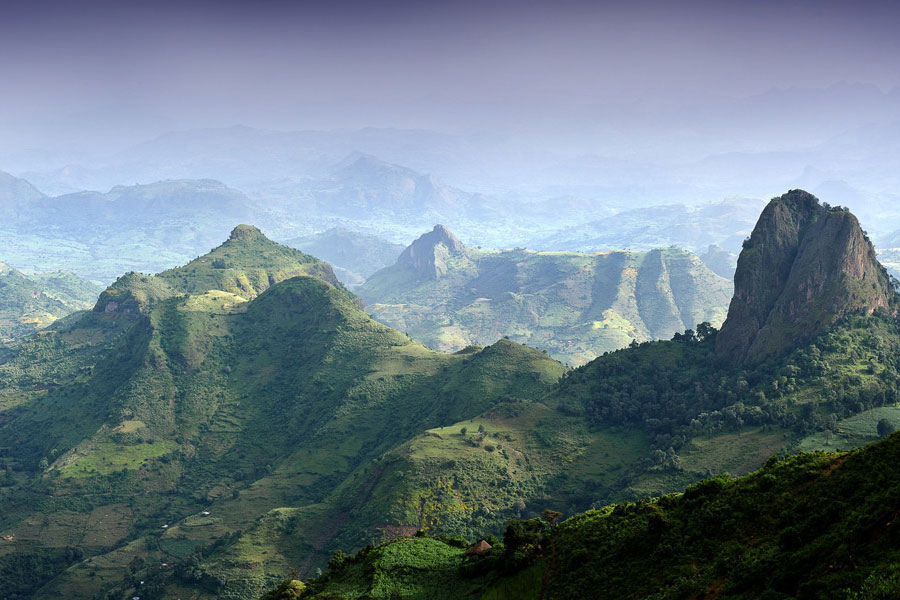
Fortune News | Nov 14,2020
A wildfire that reignited at Ethiopia’s Simien Mountains Nation Park blazed through 753ha of the park last weekend. Reignited on April 8, 2019, the fire has not been put under full control and has consumed vegetation and natural habitat areas within the park.
The initial fire began on March 26, 2019, in Gich grasslands where frequent fires occur. The fire raged for almost five days and destroyed 342ha of the park before it was put under control after a campaign and rescue efforts that mobilised many volunteers.
Apparently, the fire was smoldering and was reignited in the same area in the middle of last week, destroying another 400ha area of the park. By the end of last week, the fire in the grasslands was controlled, while the fire still remains out of control in inaccessible precipice areas.
"Firebreaks that create cleared areas and gaps in the vegetation along the fire path were established to combat the spread," said Abebaw Azanew, Park Warden of Simien Mountains Nation Park, which was established in 1969 and has 180 bird species, six species of which are endemic.
The fire killed one gelada baboon, an animal on the IUCN Red List of Threatened Species and an endemic mammal to Ethiopia; a large number of insects and rodent populations; scorched a significant grassland portion of the park; and some reports show that natural habitats of other sensitive and endemic species like the walia ibex and Ethiopian wolf were also affected.
To control the fire, rescue workers are digging ditches and establishing fire breaks, according to Abebaw.
Kummera Waqjera, director general of the Ethiopian Wild Life Conservation Authority, which administers 13 national parks that generated 123 million Br in revenue last year, supports the fire control method.
"The government is providing water, food, shelter and transportation for the fire rescue workers and volunteers," Kummera told journalists at a press conference held last Thursday, April 11, 2019.
Locals, however, complained the government's response to the fire was very slow, while rescue efforts of the farmers in the area and volunteers were immense.
"About 500 youth from the neighbouring areas flocked to the park to help with the rescue," Tomas Jejaw, one of the volunteers told Fortune.
Tomas asserts the main problem they are facing is a shortage of fire fighting equipment and tools, not human resources.
While the Authority states that sources of the fire have not been identified, the residents of the area suspect arson to be the cause.
Simien Mountains Nation Park, called one of the most spectacular landscapes in the world by UNESCO and was inscribed on the World Heritage List in 1978. However, it was put on the endangered list in 1996 due to the impact of a new road across it, excessive cattle grazing, agricultural encroachment and a drop in the population of walia ibex, Ethiopian wolf and other large mammalian species.
It was removed from the endangered list in 2017 in recognition of improvements in its management and of measures taken to reduce overgrazing and visitor impact.
Two months ago another park, Bale Mountains National Park, located 400 Km Southeast of the capital suffered wildfire that lasted for more than 20 days accross 2,600ha.
"The fire in Bale Mountains National Park was caused by human encroachment," said Mohammed Worku, a tour operator in the Park, which was established in 1970 and covers an area of 2,150 square kilometres - ten times the size of the Simien Mountains park.
Experts in the area see a pattern in both natural and human factors.
Between March and May, highland areas in the country experience hot and dry weather, according to Messay Mulugeta, an assistant professor of Socioeconomic Development Planning & Environmental Studies at Addis Abeba University's College of Development Studies.
"Hot and dry weather conditions are conducive to starting wildfires," Messay said.
Messay also listed human encroachment as an additional cause for wildfire and that the government should work on decreasing human encroachment in national parks.
"Most importantly, the government has to build capacity in case of catastrophic events such as this," he recommended.
The Ethiopia Wildlife Conservation Authority said that it is bringing a firefighter plane from South Africa for this purpose and the plane is to due to arrive on Tuesday.
Wildfire is not the only challenge in National Parks. Habitat degradation through farming and deforestation, ineffective law enforcement, lack of capacity of the park’s staff, lack of effort to protect endangered species and lack of mechanisms of sharing the benefits of the Park revenue with the local communities are among the problems.
Recently, the Authority started enacting a 10-year management plan for the national parks to preserve the natural resources through conservation and the reduction of ecological threats.
PUBLISHED ON
Apr 13,2019 [ VOL
20 , NO
989]

Fortune News | Nov 14,2020

Fortune News | Oct 15,2022

Obituary | Aug 08,2020

Viewpoints | Apr 20,2020

Radar | Jul 08,2023

Fortune News | Jun 15,2025

Featured | Oct 27,2024

Fortune News | Dec 21,2019

Fortune News | Jan 29,2022

My Opinion | Sep 23,2023

Dec 22 , 2024 . By TIZITA SHEWAFERAW
Charged with transforming colossal state-owned enterprises into modern and competitiv...

Aug 18 , 2024 . By AKSAH ITALO
Although predictable Yonas Zerihun's job in the ride-hailing service is not immune to...

Jul 28 , 2024 . By TIZITA SHEWAFERAW
Unhabitual, perhaps too many, Samuel Gebreyohannes, 38, used to occasionally enjoy a couple of beers at breakfast. However, he recently swit...

Jul 13 , 2024 . By AKSAH ITALO
Investors who rely on tractors, trucks, and field vehicles for commuting, transporting commodities, and f...

Jun 28 , 2025
Meseret Damtie, the assertive auditor general, has never been shy about naming names...

Jun 21 , 2025
A well-worn adage says, “Budget is not destiny, but it is direction.” Examining t...

Jun 14 , 2025
Yet again, the Horn of Africa is bracing for trouble. A region already frayed by wars...

Jun 7 , 2025
Few promises shine brighter in Addis Abeba than the pledge of a roof for every family...